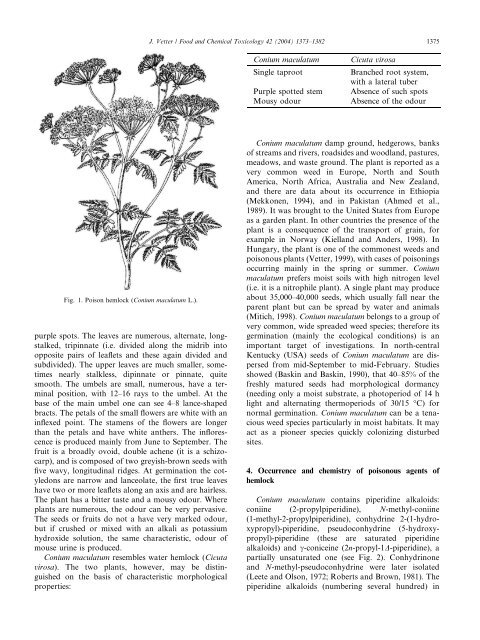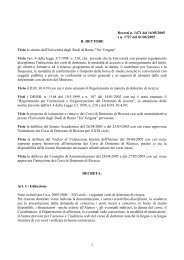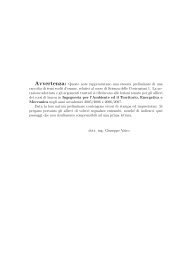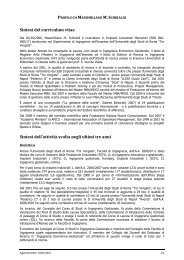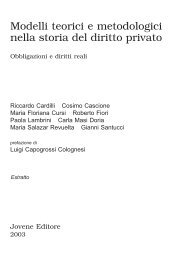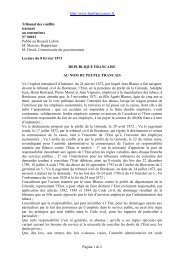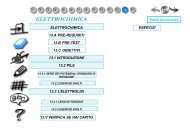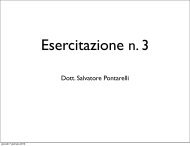You also want an ePaper? Increase the reach of your titles
YUMPU automatically turns print PDFs into web optimized ePapers that Google loves.
Fig. 1. <strong>Poison</strong> <strong>hemlock</strong> (<strong>Conium</strong> <strong>maculatum</strong> L.).<br />
purple spots. The leaves are numerous, alternate, longstalked,<br />
tripinnate (i.e. divided along the midrib into<br />
opposite pairs of leaflets and these again divided and<br />
subdivided). The upper leaves are much smaller, sometimes<br />
nearly stalkless, dipinnate or pinnate, quite<br />
smooth. The umbels are small, numerous, have a terminal<br />
position, with 12–16 rays to the umbel. At the<br />
base of the main umbel one can see 4–8 lance-shaped<br />
bracts. The petals of the small flowers are white with an<br />
inflexed point. The stamens of the flowers are longer<br />
than the petals and have white anthers. The inflorescence<br />
is produced mainly from June to September. The<br />
fruit is a broadly ovoid, double achene (it is a schizocarp),<br />
and is composed of two greyish-brown seeds with<br />
five wavy, longitudinal ridges. At germination the cotyledons<br />
are narrow and lanceolate, the first true leaves<br />
have two or more leaflets along an axis and are hairless.<br />
The plant has a bitter taste and a mousy odour. Where<br />
plants are numerous, the odour can be very pervasive.<br />
The seeds or fruits do not a have very marked odour,<br />
but if crushed or mixed with an alkali as potassium<br />
hydroxide solution, the same characteristic, odour of<br />
mouse urine is produced.<br />
<strong>Conium</strong> <strong>maculatum</strong> resembles water <strong>hemlock</strong> (Cicuta<br />
virosa). The two plants, however, may be distinguished<br />
on the basis of characteristic morphological<br />
properties:<br />
J. Vetter / Food and Chemical Toxicology 42 (2004) 1373–1382 1375<br />
<strong>Conium</strong> <strong>maculatum</strong> Cicuta virosa<br />
Single taproot Branched root system,<br />
with a lateral tuber<br />
Purple spotted stem Absence of such spots<br />
Mousy odour Absence of the odour<br />
<strong>Conium</strong> <strong>maculatum</strong> damp ground, hedgerows, banks<br />
of streams and rivers, roadsides and woodland, pastures,<br />
meadows, and waste ground. The plant is reported as a<br />
very common weed in Europe, North and South<br />
America, North Africa, Australia and New Zealand,<br />
and there are data about its occurrence in Ethiopia<br />
(Mekkonen, 1994), and in Pakistan (Ahmed et al.,<br />
1989). It was brought to the United States from Europe<br />
as a garden plant. In other countries the presence of the<br />
plant is a consequence of the transport of grain, for<br />
example in Norway (Kielland and Anders, 1998). In<br />
Hungary, the plant is one of the commonest weeds and<br />
poisonous plants (Vetter, 1999), with cases of poisonings<br />
occurring mainly in the spring or summer. <strong>Conium</strong><br />
<strong>maculatum</strong> prefers moist soils with high nitrogen level<br />
(i.e. it is a nitrophile plant). A single plant may produce<br />
about 35,000–40,000 seeds, which usually fall near the<br />
parent plant but can be spread by water and animals<br />
(Mitich, 1998). <strong>Conium</strong> <strong>maculatum</strong> belongs to a group of<br />
very common, wide spreaded weed species; therefore its<br />
germination (mainly the ecological conditions) is an<br />
important target of investigations. In north-central<br />
Kentucky (USA) seeds of <strong>Conium</strong> <strong>maculatum</strong> are dispersed<br />
from mid-September to mid-February. Studies<br />
showed (Baskin and Baskin, 1990), that 40–85% of the<br />
freshly matured seeds had morphological dormancy<br />
(needing only a moist substrate, a photoperiod of 14 h<br />
light and alternating thermoperiods of 30/15 °C) for<br />
normal germination. <strong>Conium</strong> <strong>maculatum</strong> can be a tenacious<br />
weed species particularly in moist habitats. It may<br />
act as a pioneer species quickly colonizing disturbed<br />
sites.<br />
4. Occurrence and chemistry of poisonous agents of<br />
<strong>hemlock</strong><br />
<strong>Conium</strong> <strong>maculatum</strong> contains piperidine alkaloids:<br />
coniine (2-propylpiperidine), N-methyl-coniine<br />
(1-methyl-2-propylpiperidine), conhydrine 2-(1-hydroxypropyl)-piperidine,<br />
pseudoconhydrine (5-hydroxypropyl)-piperidine<br />
(these are saturated piperidine<br />
alkaloids) and c-coniceine (2n-propyl-1D-piperidine), a<br />
partially unsaturated one (see Fig. 2). Conhydrinone<br />
and N-methyl-pseudoconhydrine were later isolated<br />
(Leete and Olson, 1972; Roberts and Brown, 1981). The<br />
piperidine alkaloids (numbering several hundred) in


